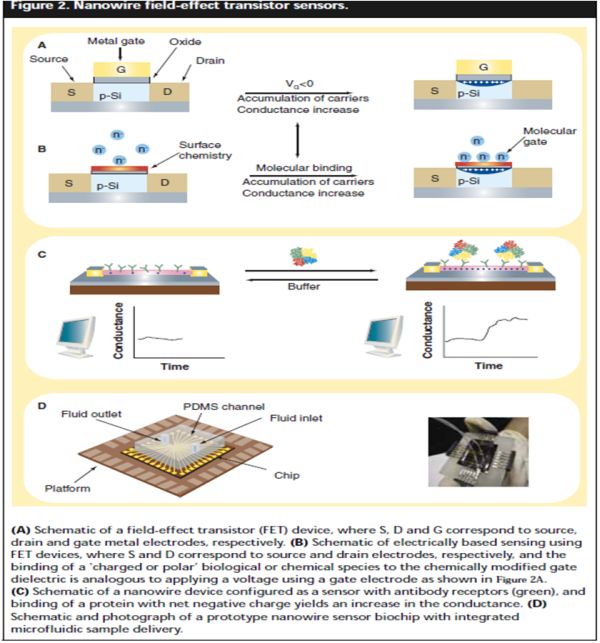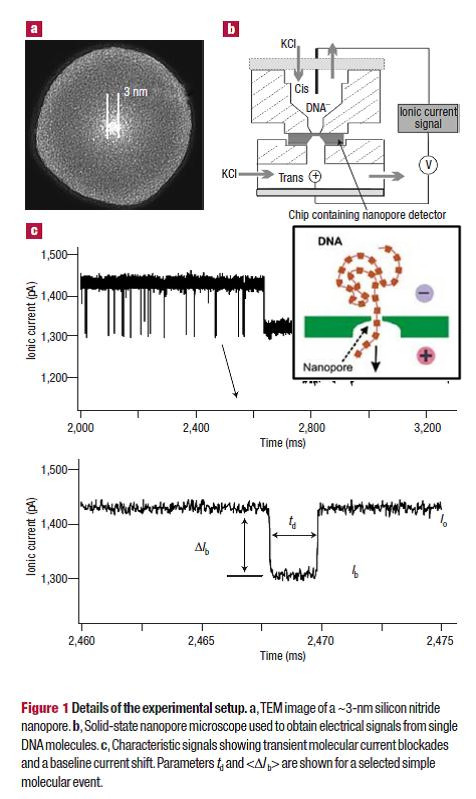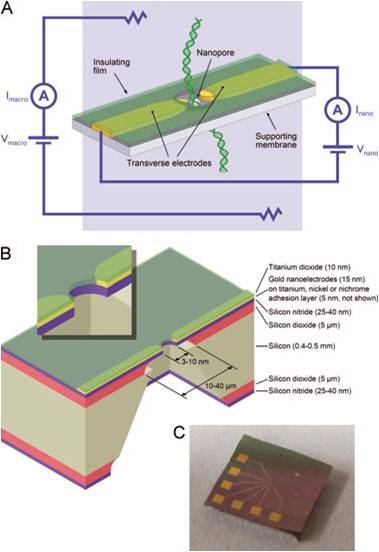

Overview of Medical Applications
Our interest in the development of nanowire biosensors, and nanopore bio-detectors is partly due to our work on the development of sensitive amplifiers that are based on silicon nanowires. Qusemde always welcome the opportunity to explore subcontracting work on the development of nanowire biosensors. Preferred partners are the typical biotech instrument manufacturers and researchers in government laboratories. Our interest in the development of nanopore detectors is more aspirational, and hence it can be driven more by collaboration than by a contract. It is possible to write a contract for the development of nanowire sensors because the cost and path to the deliverables can be specified. In contrast, in the case of nanopore detectors there are too many unknowns in the method of fabrication. The principle and operation of nanopore detectors has been well demonstrated in academic laboratories. Fabrication of those kinds of sensors in a commercial process is a formidable task. It is our goal to develop novel types of nanopore detectors using CMOS.
The following introductions to nanowire and nanopore sensors are intended for those who are not in the field but are interested in our work; that group includes potential employment candidates (circuit designers, etc.), and investors (venture capitalist, etc.).
Introduction to nanowire sensors for medical applications
The silicon nanowire biosensor is emerging as a powerful device with technological applications ranging from health monitoring to drug discovery; and scientific applications in biology. Nanowire biosensor represents a transformative technology and could fundamentally change some aspects of patient care. For example the real time capability of siNW biosensors could change how physicians, and pharmaceutical researchers monitor a variety of blood biomarkers. Nanowire biosensors are also expected to replace some of the traditional biosensors; and that is because 1) the traditional sensors are not label free and typically require a significant amount of sample preparation and 2) the detection sensitivity is low.
A tutorial overview of 1) the operation of a FET, 2) a nanowire configured as a sensor, and 3) an integrated sensor chip is shown in the attached figure.

|
| Figure 1. |
Introduction to nanopore biosensors
Nanometer size channels (nanopores) in the membrane of cells can function as electromechanical devices that assist in the regulation of molecular transport, and ion flow into and out of the cell. In the 1990s it was demonstrated that biological nanopores, and solid state nanopores can be used to detect single molecules. Nanopores are currently under intense investigation primarily because it can be part of a sensor that enables a revolutionary method of sequencing DNA. The basic concept of a nanopore biosensor and sequencing can be gleaned from figure 1. Electrolytes in two chambers are connected by only a nanopore, and a voltage is applied to electrodes in each chamber. The voltage drives ions through the nanopore and the ionic current can be measured. If DNA molecules are placed in the cathodic chamber (customarily labeled Cis) then the DNA is electrophoretically driven through the nanopore, thereby blocking the ionic current as it transits through the nanopore. That change in the ionic signal is easy to measure, and it varies depending on the characteristic of the molecule. Software that can recognize the distinct signature for each base (adenine, guanine, thymine or cytosine) can then produce the sequence in real time.

|
| Figure 2. Illustration taken from Ref. 2 |
Another method to detecting the DNA moving through the pore is to place electrodes on the nanopore detector, transverse to the flow direction, and measure the tunneling current. See figure 3.

|
| Figure 3. See Ref. 3 |
References
- Kasianowicz, J. J., Brandin, E., Branton,D. and Deamer,D. W. Characterization of individual polynucleotide molecules using a membrane channel. Proc.Natl Acad. Sci. USA 93, 13770–13773 (1996).
- Li, J., Gershow, M., Stein, D., Brandin, E. and Golovchenko, J.,`` DNA molecules and configurations in a solid-state nanopore,’’ Nature Materials. 2, 611 615 (2003).
- K. Healy, V. Ray, L. J. Willis, N. Peterman, J. Bartel, M. Drndic, ``Fabrication and characterization of nanopores with insulated transverse nanoelectrodes for DNA sensing in salt solution,’’ Electrophoresis 2012, 33, 3488–3496
- Zwolak, M. and Di Ventra, M. Colloquium: Physical approaches to DNA sequencing and detection. Reviews of Modern Physics, 80 (1). pp. 141-165 (2008)